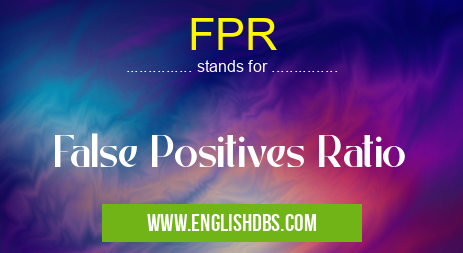What does FPR mean in UNCLASSIFIED
FPR stands for False Positives Ratio. It is a statistical measure used to evaluate the performance of a classification model. It represents the proportion of negative cases that are incorrectly classified as positive by the model.

FPR meaning in Unclassified in Miscellaneous
FPR mostly used in an acronym Unclassified in Category Miscellaneous that means False Positives Ratio
Shorthand: FPR,
Full Form: False Positives Ratio
For more information of "False Positives Ratio", see the section below.
Meaning of FPR
In a classification task, the model aims to correctly identify two types of cases: positive cases (actual positives) and negative cases (actual negatives). However, models may make mistakes and classify some negative cases as positive. This is referred to as a false positive.
The FPR is calculated by dividing the number of false positives by the total number of negative cases:
FPR = False Positives / Total Negatives
A low FPR indicates that the model is good at discriminating between positive and negative cases, while a high FPR indicates that the model is making a significant number of false positive predictions.
Significance of FPR
FPR is an important metric for evaluating the performance of classification models, particularly in situations where the cost of false positives is high. For instance, in medical diagnostics, a false positive result can lead to unnecessary or harmful treatments.
Essential Questions and Answers on False Positives Ratio in "MISCELLANEOUS»UNFILED"
What is False Positives Ratio (FPR)?
False Positives Ratio (FPR) is a metric in machine learning that measures the proportion of negative instances that are incorrectly classified as positive. It is expressed as the ratio of false positives to the total number of negative instances.
How is FPR calculated? A: FPR is calculated using the following formul
FPR is calculated using the following formula:
FPR = FP / (FP + TN)Where:
- FP is the number of false positives
- TN is the number of true negatives
What does a high FPR indicate?
A high FPR indicates that the model is making a significant number of mistakes in classifying negative instances as positive. This can lead to false alarms or incorrect predictions.
What does a low FPR indicate?
A low FPR indicates that the model is correctly classifying most negative instances. This suggests that the model is reliable in distinguishing between positive and negative classes.
How can I reduce FPR? A: There are several techniques to reduce FPR, including: Adjusting the classification threshold: Raising the threshold can decrease FPR but may also increase False Negatives Ratio (FNR). Using a different classification algorithm: Some algorithms are more effective at minimizing FPR than others. Improving the training dat
There are several techniques to reduce FPR, including:
- Adjusting the classification threshold: Raising the threshold can decrease FPR but may also increase False Negatives Ratio (FNR).
- Using a different classification algorithm: Some algorithms are more effective at minimizing FPR than others.
- Improving the training data: Removing noisy or ambiguous data can help the model learn to distinguish between positive and negative instances more accurately.
Is FPR more important than other metrics?
The importance of FPR depends on the specific application. In some cases, a high FPR may be acceptable if the consequences of false positives are minimal. However, in other cases, a low FPR is critical to ensure accurate predictions and avoid costly mistakes.
Final Words: FPR is a useful metric for assessing the accuracy of classification models. It helps to quantify the model's ability to correctly identify negative cases and avoid false positive predictions. By considering FPR along with other metrics such as True Positive Rate (TPR) and Accuracy, it is possible to evaluate the overall performance of a classification model and make informed decisions about its suitability for a particular application.
